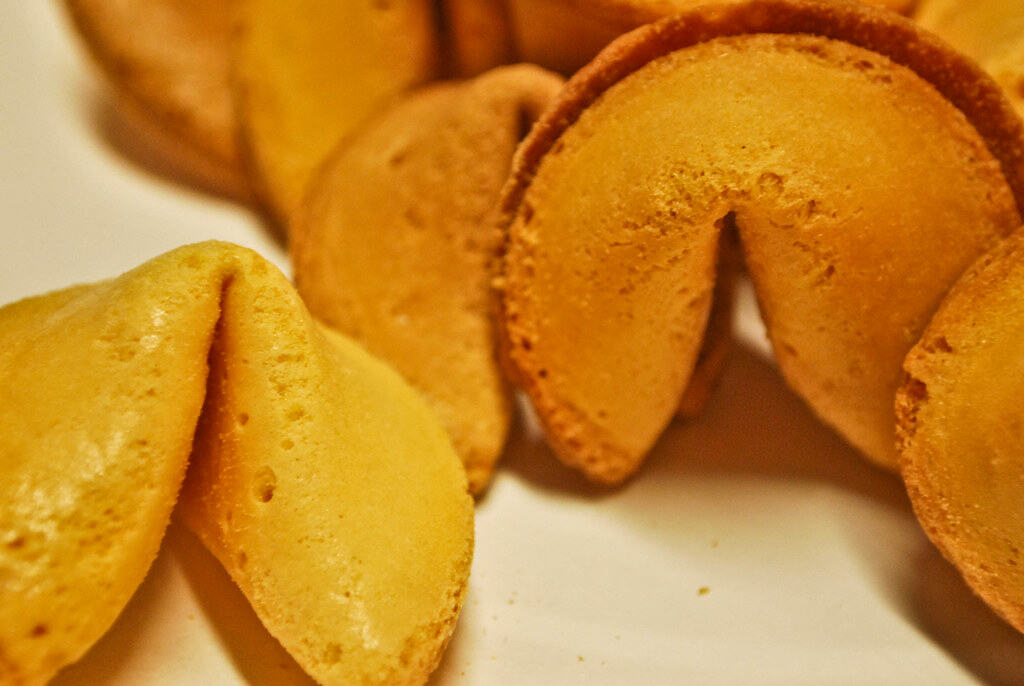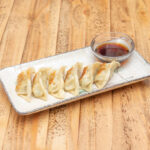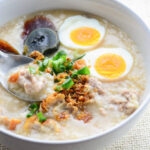Crisp and delicious biscuits called fortune cookies are frequently offered as dessert in Chinese restaurants. The cookies are typically made from a mixture of flour, sugar, vanilla, and sesame oil, and they are shaped into small, flat circles.
The distinctive feature of fortune cookies is the small piece of paper inside that contains a fortune or a piece of advice. The fortunes are usually printed in black ink on a small strip of paper and inserted into the cookie before it is baked. The fortunes can be humorous, inspiring, or even prophetic.
The exact origins of the fortune cookie are not clear, but it is believed to have been invented in California in the late 19th or early 20th century. Some sources credit the invention of the fortune cookie to the Japanese, while others suggest that it was created by Chinese immigrants to the United States.
Today, fortune cookies are a popular part of Chinese cuisine and are often served as a dessert or as a complimentary item with a meal in Chinese restaurants. They are also sometimes used in fortune-telling games or as party favors.
| Ingredients: | |
| 1 | 1/2 cup all-purpose flour |
| 2 | 1/2 cup granulated sugar |
| 3 | 2 large egg whites |
| 4 | 1/2 teaspoon vanilla extract |
| 5 | 1/2 teaspoon almond extract |
| 6 | 2 tablespoons vegetable oil |
| 7 | 3 tablespoons water |
Step-by-step cooking instructions of Fortune Cookie:
Step-1 Put a baking sheet in the oven and preheat it to 350 degrees.
Step-2 In a medium bowl, whisk together the flour and sugar.
Step-3 In a separate bowl beat the egg whites until they are frothy.
Step-4 Add the vanilla extracts, almond extract, vegetable oil, and water to the egg whites and mix until well combined.
Step-5 Add the flour mixture to the egg white mixture and stir until the batter is smooth.
Step-6 Drop tablespoons of batter onto the prepared baking sheet, spacing them about 3 inches apart.
Step-7 Spread the batter into a thin circle with a diameter of about 3 inches using the back of a spoon.
Step-8 Bake for 10 to 12 minutes, or until the edges are just starting to turn golden.
Step-9 Remove the cookies from the oven and immediately place a fortune or message in the center of each cookie.
Step-10 Use a spatula to gently fold the cookie in half, pinching the edges together to form a crease in the center.
Step-11 Hold the folded cookie with your thumbs on the bottom and your fingers on the top and bend the ends downward to form the classic fortune cookie shape.
Step-12 Repeat with the remaining batter until all of the cookies are made.
Step-13 Allow the cookies to cool completely before serving.
Nutritional value of Fortune Cookie:
Crisp and delicious biscuits called fortune cookies are frequently offered as dessert in Chinese restaurants. They are relatively low in calories, but also low in nutrients. The nutritional value of a typical fortune cookie can vary slightly depending on the recipe, but here is a general breakdown of the nutritional information for one cookie:
| 1 | Calories: 32 |
| 2 | Total Fat: 0.5g |
| 3 | Saturated Fat: 0.1g |
| 4 | Cholesterol: 0mg |
| 5 | Sodium: 16mg |
| 6 | Total Carbohydrates: 6.6g |
| 7 | Dietary Fiber: 0.1g |
| 8 | Sugars: 3.5g |
| 9 | Protein: 0.6g |
Fortune cookies are relatively low in calories and fat, but they are also low in fiber and protein. They do contain a small amount of sugar and sodium, so it’s best to consume them in moderation as part of a balanced diet.
Background History of Fortune Cookie:
The fortune cookie is a crisp and sugary cookie with a paper slip inside, containing a fortune or a prediction. Although it has become synonymous with Chinese cuisine, the fortune cookie did not originate in China.
The fortune cookie is believed to have been created in the United States in the early 1900s. There are a few different stories about the origin of the fortune cookie, but one of the most widely accepted is that it was invented by a Japanese immigrant named Makoto Hagiwara.
Hagiwara was the caretaker of the Japanese Tea Garden in San Francisco’s Golden Gate Park, and he is credited with introducing the idea of serving tea and fortune cookies at the garden. The fortune cookies were originally made by hand, and the fortunes were written by Hagiwara himself.
Another theory is that the fortune cookie was created by a Chinese immigrant named David Jung, who owned the Hong Kong Noodle Company in Los Angeles. According to this theory, Jung invented the cookie in the 1920s and handed them out to customers as a promotional tool.
Regardless of its true origins, the fortune cookie became a popular tradition in Chinese restaurants throughout the United States. Today, fortune cookies are widely associated with Chinese cuisine, but they are not commonly found in China. Instead, they are primarily a Western invention that has become a cultural phenomenon.
| Advantages of Fortune Cookie: | |
| 1 | Fun and Entertaining: Fortune cookies are a fun and entertaining way to end a meal at a Chinese restaurant. People enjoy cracking open the cookie to see what fortune or prediction is inside, and it adds a lighthearted element to the dining experience. |
| 2 | Marketing Tool: Fortune cookies can be a great marketing tool for businesses. Companies can print their logo or message on the fortune slip, which will be seen by the person who receives it. |
| 3 | Cultural Icon: Fortune cookies have become a cultural icon in the United States and are often associated with Chinese cuisine. They can be used to introduce people to Chinese culture and customs. |
| 4 | Memorable Experience: Fortune cookies can make a meal at a Chinese restaurant a memorable experience. Customers may remember the unique and playful aspect of the fortune cookie and return to the restaurant again. |
| Disadvantages of Fortune Cookie: | |
| 1 | Inauthentic: Fortune cookies are not a traditional Chinese dessert, and they are not commonly found in China. Therefore, they may be viewed as inauthentic and not reflective of true Chinese cuisine. |
| 2 | Wasteful: The packaging and paper slips that come with fortune cookies can contribute to waste. The slips are often discarded after reading, and the packaging is not always recyclable. |
| 3 | Limited Variety: The fortunes inside fortune cookies are often limited to generic or cliché sayings, and they do not offer a lot of variety. This can make the experience of opening a fortune cookie predictable and less exciting. |
| 4 | Misleading Predictions: Some people may take the predictions or fortunes inside fortune cookies too seriously, leading to disappointment or false expectations. These predictions are not based on any real science or psychic ability, and they should not be taken too seriously. |
Compare with Similar meal of Fortune Cookie:
There are no direct similar meals to the fortune cookie, as it is a unique and distinctive dessert. However, there are other desserts and treats that may be similar in some ways:
| 1 | Biscotti: Like fortune cookies, biscotti are a crisp and crunchy cookie. They can be served with coffee or tea and often come in a variety of flavors. |
| 2 | Macaroons: Macaroons are a delicate and colorful French cookie that can be filled with a variety of flavors. They’re frequently offered as dessert or a snack. |
| 3 | Mochi: Mochi is a Japanese dessert made from sweet rice flour that is often filled with sweet or savory ingredients. Like fortune cookies, they can be a fun and playful way to end a meal. |
| 4 | Pocky: Pocky is a Japanese snack that consists of a biscuit stick dipped in chocolate or other flavors. It is suitable for dessert or a snack. |
| 5 | Gelato: Gelato is a creamy and flavorful Italian ice cream. It comes in a variety of flavors and can be served as a dessert or treat. |
Mostly question asked about Fortune Cookie:
1: What are fortune cookies made of?
A: Fortune cookies are made from a mixture of flour, sugar, vanilla, and oil. The batter is then baked into thin, crispy cookies.
2: Are fortune cookies Chinese?
A: Although fortune cookies are often associated with Chinese cuisine, they are not traditionally Chinese. In the early 1900s, they were created in the United States.
3: How are fortunes put inside fortune cookies?
A: Fortunes are printed on slips of paper, which are then folded and inserted into the cookies after they are baked and still warm. The cookies are then folded in half to create their distinctive shape.
4: Do fortune cookies always contain fortunes?
A: Fortune cookies typically contain a slip of paper with a fortune or prediction, but some cookies may contain jokes or other messages.
5: Can you make your own fortune cookies?
A: Yes, it is possible to make fortune cookies at home using a basic recipe and a special fortune cookie folding technique. Online resources for recipes and instructions abound.
6: Are fortune cookie fortunes accurate?
A: Fortune cookie fortunes are not based on any scientific or psychic method and should not be taken too seriously. They’re supposed to be enjoyable and lighthearted.
7: Can you eat the fortune inside the cookie?
A: Yes, the fortune inside the cookie is safe to eat, but it is not recommended. The paper may have chemicals or inks that are not intended for consumption.
8: How many fortune cookies are made each day?
A: 4.5 million fortune cookies
The majority of the 3 billion fortune cookies produced worldwide each year are consumed in the United States. Wonton Food Inc., with its main office in Brooklyn, New York, is the company that produces the most cookies. Every day, they produce more than 4.5 million fortune cookies!
9: What is the longest fortune cookie?
A: Nick DiGiovanni (USA) and Uncle Roger (Malaysia) made the world’s largest fortune cookie on November 12, 2022, in Boston, Massachusetts, weighing 1.47 kg (3 lb 3 oz). It took three individuals about four hours to make the 40 X 17 cm (6 X 7 in) cookie.
10: Can you take 2 fortune cookies?
A: Because the fortune-cookie-fairy owes you one fortune, if there isn’t a fortune in a fortune cookie, excellent things are about to happen to you soon. Two fortunes in a single cookie are irrelevant to one another. The next cookie’s fortune will be the one you get.







